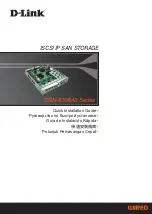
Installation and operating instructions Wilo-RexaBloc RE/Rexa BLOC 39
INSTALLATION English
4.1.
Delivery
Upon delivery, check immediately that the shipment is
complete and undamaged. If any parts are damaged or
missing, the transport company or the manufacturer must be
notified on the day of delivery since claims cannot be made
afterwards. Damage to parts must be noted on the freight
documentation!
4.2.
Transportation
Only the designated and approved fastening devices, trans-
portation and lifting equipment may be used for transpor-
tation. These must have sufficient load-bearing capacity to
ensure that the hydraulics can be transported safely. When
using chains, these must be secured against slipping.
Personnel must be qualified for the tasks and must follow all
applicable national safety regulations during the work.
The hydraulics is delivered by the manufacturer or shipping
agency in suitable packaging. This normally precludes the
possibility of damage occurring during transportation and
storage. The packaging should be stored safely for reuse if
the product is frequently used at different locations.
Note the additional information in the operating and
maintenance manual of the motor manufacturer regarding
transportation.
4.3.
Storage
Newly supplied hydraulics are prepared so that they can be
stored for at least 1 year. The hydraulics should be cleaned
thoroughly before they are put into temporary storage!
Note the additional information in the operating and main-
tenance manual for the motor regarding “storage”.
The following should be taken into consideration for storage:
•
Place the hydraulics on a firm surface and secure it
against slipping and falling over. Sewage hydraulics are
stored horizontally.
DANGER due to risk of falling over!
Never set the hydraulics down if unsecured.
If the hydraulics falls over, this may lead to
injuries!
• Our hydraulics can be stored at temperatures down to
-15 °C. The storeroom must be dry. We recommend a
frost-protected room for storage with a temperature
between 5 °C and 25 °C.
• The hydraulics must not be stored in rooms in which
welding work is carried out because the resulting gases
or radiation can damage the elastomer components and
coating.
• Suction and discharge connections must be sealed
securely to prevent contamination getting in.
• The hydraulics must be protected from direct sunlight,
heat, dust and frost. Heat or frost can cause serious
damage to impellers and coatings!
• The impellers should be checked at regular intervals.
This prevents the bearings from jamming and renews the
lubrication film on the mechanical seal.
WARNING! Sharp edges!
Sharp edges may form on the impeller and
on the openings of the suction and discharge
ports. There is a risk of injury! Wear the nec-
essary protective clothing, such as protective
gloves.
• If the hydraulics has been stored for a long period of
time, it should be cleaned of impurities such as dust
and oil residue before commissioning. Check that the
impellers move freely and check the housing coatings for
damage.
Prior to commissioning, the fill level in the sealing chamber
should be checked and topped up, if necessary!
Damaged coatings must be repaired immediately. Only an
intact coating fulfils its intended purpose!
Please note that elastomer components and coatings
become naturally brittle over time. If the product is to be
stored for longer than 6 months, we recommend checking
these parts and replacing them as necessary. Please consult
Wilo customer service for details.
4.4.
Return delivery
Hydraulics that are returned to the factory must be properly
packaged. This means that impurities have been cleaned
from the hydraulics and that it has been decontaminated if
used to pump fluids that are hazardous to health.
For shipping, the parts must be packed in tear-proof plastic
bags of sufficient size in such a manner that they are tightly
sealed and leak-proof. Furthermore, the packaging must pro-
tect the hydraulics from damage during transportation. If you
have any questions, please contact Wilo customer service!
5.
Installation
In order to prevent damage to the device or serious injury
during installation, the following points must be observed:
• Installation work – assembly and installation of the
hydraulics – may only be carried out by qualified per
-
sons. The safety instructions must be followed at all
times.
• The hydraulics must be inspected for transport damage
before any installation work is carried out.
5.1.
General
For design and operation of technical sewage systems,
observe the pertinent local regulations and directives for
sewage technology (such as those of sewage technology
associations).
Note that, in stationary installations, pressure surges can
occur in cases where water is pumped with longer discharge
pipelines (especially with steady ascents or steep terrain).
Pressure surges can result in destruction of the hydraulics/
system and noise pollution due to flap knock. Pressure surges
can be prevented by applying suitable measures (e.g. swing
check valves with an adjustable closing time or special rout-
ing of the discharge pipeline).
Air pockets in the hydraulics or pipeline system must be
avoided at all costs and must be removed using a suitable
ventilation system.
Protect the hydraulics from frost.
















































